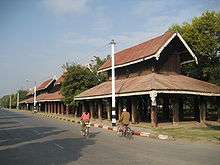Thudhamma Nikaya

Thudhamma Nikaya (Burmese: သုဓမ္မာနိကာယ, IPA: [θudəma̰ nḭkàja̰]; also spelt Sudhammā Nikāya) is the largest monastic order of monks in Burma, with 85-90% of Burmese monks (250,000) belonging to this order.[1] It is one of 9 legally sanctioned monastic orders (nikaya) in the country, under the 1990 Law Concerning Sangha Organizations.[2] Thudhamma is considered a more pragmatic order than the Shwegyin Nikaya, with looser rules regarding Vinaya regulations and is less hierarchical than the former.[3] Like all the major orders in Burma, Thudhamma Nikaya prohibits monks from engaging in political activity.[4]
Origins
Thudhamma Nikaya was founded in the late 18th century by King Bodawpaya, after a series of Sangha reforms by prior Konbaung kings to purify and unite the Sangha. The name 'Thudhamma' comes from the Thudhamma Council (an ecclesiastical organization founded by Bodawpaya), which in turn is named after Mandalay's Thudhamma Zayats, the meeting grounds for the Council.[5]
The office of the Supreme Patriarch (သာသနာပိုင် or Thathanabaing), similar to the position of Sangharaja in Thailand and Cambodia, dates back to the 13th century, started by the monk Shin Arahan in the Pagan Kingdom.[6] The Thathanabaing was responsible for managing the monastic hierarchy and education at monasteries. In 1784, King Bodawpaya assembled the Thudhamma Council, led by the Thathanapaing and four elders (ထေရ် or thera) to resolve a longstanding issue on the proper wearing of monk's robes (whether one or both shoulders should be exposed).[6] Toward the end of the Konbaung dynasty, the council, which oversaw religious affairs in the kingdom, including the appointment of monastery abbots, Vinaya regulations, discipline of individual monks, and administration of Pali examination, was expanded to include 8 elders.[6]
References
- ↑ http://philtar.ucsm.ac.uk/encyclopedia/seasia/thuddama.html
- ↑ Gutter, Peter (2001). "Law and Religion in Burma" (PDF). Legal Issues on Burma Journal. Burma Legal Council (8): 10.
- ↑ Matthews, Bruce (1993). "Buddhism under a Military Regime: The Iron Heel in Burma". Asian Survey. University of California Press. 33 (4): 411. doi:10.1525/as.1993.33.4.00p02742. JSTOR 2645106.
- ↑ Aung-Thwin, Michael (2009). "Of Monarchs, Monks, and Men: Religion and the State in Myanmar" (PDF). Working Paper Series No. 127. Asia Research Institute (18).
- ↑ Carbine, Jason A (2011). Sons of the Buddha: Continuities and Ruptures in a Burmese Monastic Tradition. 50. Walter de Gruyter. ISBN 978-3-11-025409-9.
- 1 2 3 James, Helen (2005). Governance and civil society in Myanmar: education, health, and environment. Psychology Press. p. 81. ISBN 978-0-415-35558-2.
